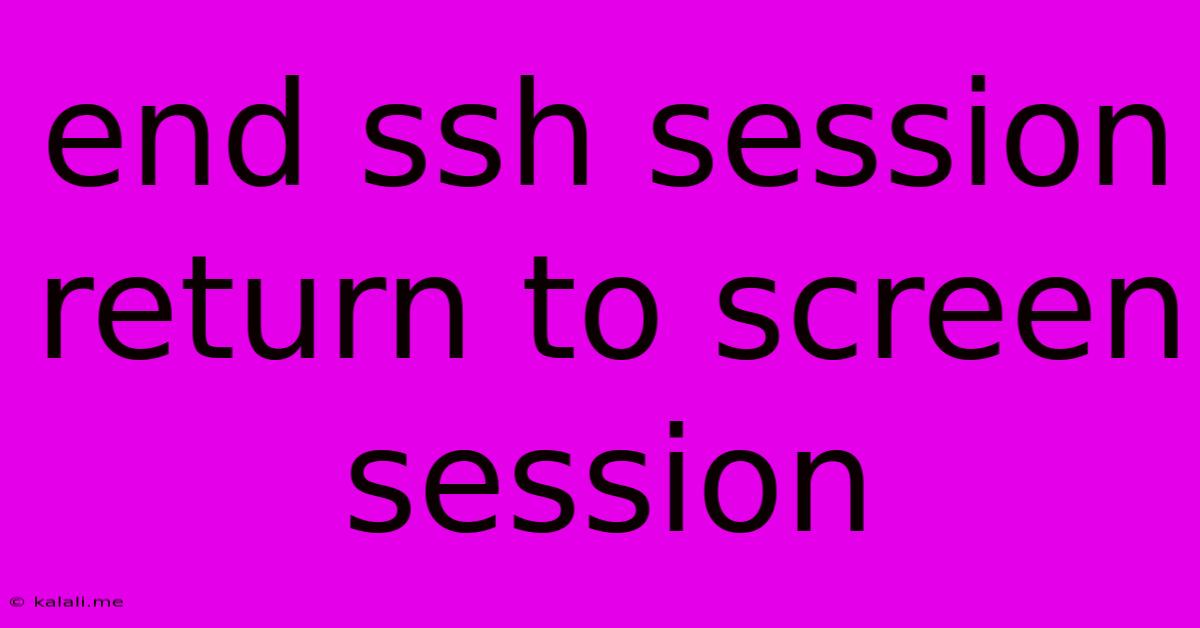End Ssh Session Return To Screen Session
Kalali
May 24, 2025 · 3 min read

Table of Contents
End SSH Session, Return to Screen Session: A Seamless Transition
This article provides a comprehensive guide on how to seamlessly disconnect from an SSH session without losing your active screen session. Losing work due to an unexpected SSH disconnect is frustrating; this guide will show you how to avoid that. We'll cover various scenarios and offer troubleshooting tips to ensure your screen sessions remain intact.
Why Use Screen Sessions?
Screen sessions are invaluable for managing multiple processes and commands remotely. They act as a persistent shell, allowing you to detach from an SSH session and reconnect later, picking up exactly where you left off. This is particularly useful for long-running processes, tasks requiring significant time, or simply maintaining multiple terminal sessions simultaneously.
The Importance of Detachment, Not Termination
The key to maintaining your screen session is to detach from it, not terminate it. Terminating the session (e.g., by simply closing the SSH connection without detaching) will end all processes running within the screen. Detaching, however, suspends the screen session in the background, allowing you to resume it later.
Methods for Detaching from a Screen Session
There are several ways to detach from your screen session gracefully:
-
Ctrl+a, then d: This is the most common and straightforward method. Press
Ctrl+a(hold down the Ctrl key and press 'a'), then press 'd'. This will detach your screen session, leaving it running in the background. -
screen -d(From Another Screen Session): If you have multiple screen sessions running and want to detach a specific one, you can use this command from another active screen session. You'll need to know the screen's session ID (often displayed when you start a session). -
screen -X detach(From Within the Session): You can also use this command within the screen session itself to detach.
Reconnecting to Your Screen Session
Reconnecting to a detached screen session is equally simple. Connect to your server via SSH as usual. Then:
screen -r: This command will reattach you to your most recently used screen session. If you have multiple sessions, you might need to specify the session ID (e.g.,screen -r <session_id>).
Troubleshooting Common Issues
-
Screen session not found: Double-check your SSH connection details and the command used to reconnect. Ensure that you're connecting to the correct server and that the screen session is still active.
-
Permission errors: Make sure you have the necessary permissions to access and manage screen sessions on the remote server.
-
Multiple screen sessions: If you have multiple screen sessions running, you may need to identify the correct session ID using
screen -ls(list sessions). -
Session already attached: This error means you're already connected to the screen session. Close the current SSH window or terminal if you want to re-connect from a different window.
Best Practices for Screen Session Management
-
Name your sessions: Using meaningful names for your sessions (e.g.,
screen -S my_database_work) makes it easier to manage multiple sessions. -
Regularly save your sessions: While screen sessions usually persist across disconnections, it's good practice to save them periodically using
screen -sto create a snapshot. This provides an extra layer of protection against data loss. -
Use a screen multiplexer alternative (tmux): If you find Screen lacking in features or ease of use, consider exploring alternatives like tmux, which offers similar functionality with a potentially more intuitive interface.
By following these steps and best practices, you can confidently manage your remote sessions, ensuring a seamless transition between SSH connections and your persistent screen sessions, preventing accidental data loss and maximizing your productivity.
Latest Posts
Latest Posts
-
If Your 35 What Year Was You Born
Jul 12, 2025
-
How Many Cups Is 1 Pound Of Cheese
Jul 12, 2025
-
30 X 30 Is How Many Square Feet
Jul 12, 2025
-
How Much Does A Half Oz Weigh
Jul 12, 2025
-
Calories In An Omelette With 3 Eggs
Jul 12, 2025
Related Post
Thank you for visiting our website which covers about End Ssh Session Return To Screen Session . We hope the information provided has been useful to you. Feel free to contact us if you have any questions or need further assistance. See you next time and don't miss to bookmark.